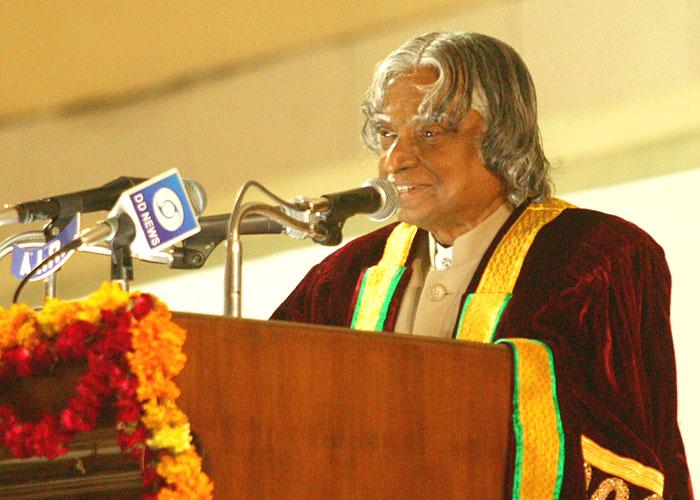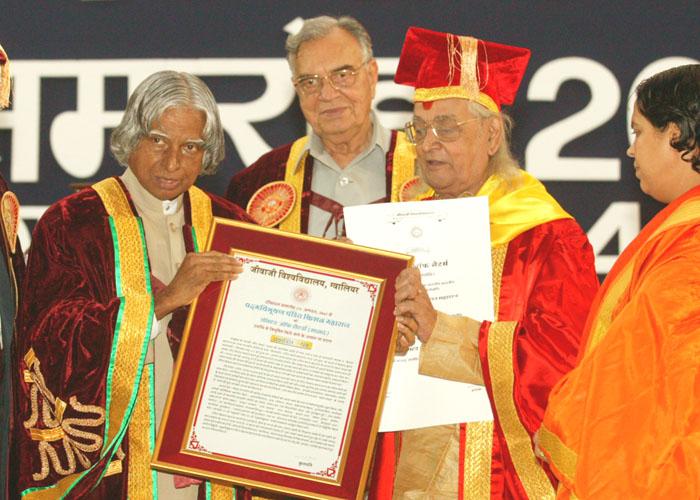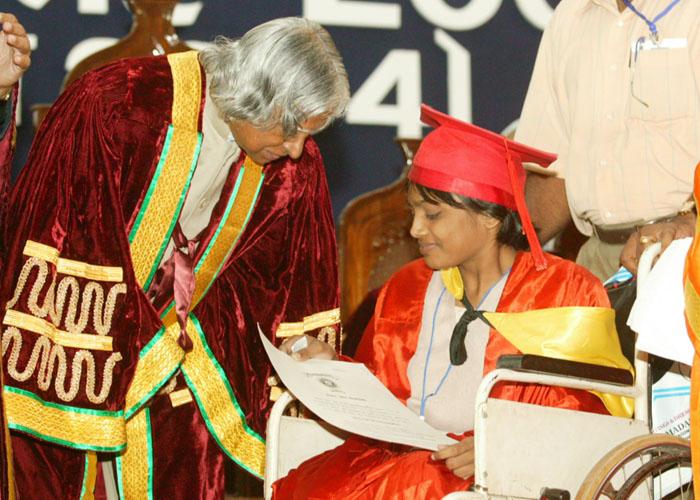Address At The Convocation Of Jiwaji University, Gwalior
Gwalior : 10-08-2004
Employment Generation through Entrepreneurship
I am indeed delighted to participate in the Annual Convocation of Jiwaji University. I take this opportunity to wish the University students for their academic performance. I greet the Chancellor, Vice Chancellor, Professors, teachers and staff for shaping the young minds to contribute to the nation in multiple fields. Dear graduates, when you go out of this university, the education and empowerment that you have received will be with you to meet any challenge. You will be a winner if you have a tall aim, if you can sweat for achieving the aim and indomitable spirit to overcome any problem you face in your life.
Our National mission - challenges
Our nation is going through a major challenge of uplifting of 260 million people who are below the poverty line. They need habitat, they need food, they need health care, and they need education and employment and finally resulting into a good life. Our GDP is growing at more than 5% per annum. Whereas, the economists suggest that to uplift the people below poverty line, our economy has to grow at the rate of 10% per annum consistently, for over a decade.
Integrated action
To meet the need of one billion people, we have the mission of transforming India into a developed nation. We have identified five areas where India has a core competence for integrated action: (1) Agriculture and food processing (2) Reliable and Quality Electric power, Surface transport and Infrastructure for all parts of the country. (3) Education and Healthcare (4) Information and Communication Technology (5) Strategic sectors. These five areas are closely inter-related and if well done would lead to national, food, economic and security.
Essential Connectivities
The integrated methods, which will bring prosperity to rural India are: the physical connectivity of the village clusters through quality roads and transport; electronic connectivity through tele-communication with high bandwidth fiber optic cables reaching the rural areas from urban cities and through internet kiosks; knowledge connectivity through education, vocational training for farmers, artisans and craftsmen and entrepreneurship programmes; these three connectives leading to economic connectivity through starting of enterprises with the help of banks, micro credits and marketing the products.
PURA Model
Majority of our population lives in villages. The development of the nation requires enhancement of economic connectivity of the villages. The Jiwaji University can take this as a theatre of action. Out of the 55 thousand villages in Madhya Pradesh about 400 PURA complexes would emerge. Jiwaji University can enable the planning of PURA model to be implemented in Madhya Pradesh keeping the following variables in mind:
(a) number of villages per complex
(b) number of village-complexes for the state
(c) crop pattern for different complexes based on soil, weather, core competence, water availability and region (hilly, plain or dryland)
(d) cultivation methods
(e) food processing units
(f) marketing centres
Creation of Village Level Industries
The model should enable proper selection of clusters and deployment of farmers in different areas of agriculture, agro processing and the market to make this programme a reality. They should create a holistic plan of product, skill and entrepreneurship. Determination of products should be done on the basis of the core strength of the region and the availability of raw materials and infrastructure. Once the product is determined it will also involve infusion of new technologies for making it attractive for both national and international market and also productivity enhancement.
Jiwaji University can play a very important role to establish the process and methods of a vocational training package for improving the skill sets of the rural population. This is also the time for developing entrepreneurs with leadership qualities who will then create and nurture the enterprise. This will enable creation of the village level industries simultaneously with the establishment of connectivities in the region.
Employment Generation
There has been substantial growth in our higher educational system and we are generating over 3 million graduates every year. However our employment generation system is not in a position to absorb the graduates passing out from the universities leading to increase in educated unemployed, year after year. This situation will lead to instability in the social structure. We need higher education backed by employment opportunities. A multi pronged strategy is needed to make education more attractive and simultaneously create employment potential ? how do we do that?
Development Partners : Industries, Banks and Universities
Firstly, the educational system should highlight the importance of entrepreneurship and prepare the students right from the college education to get oriented towards setting up of the small scale industrial enterprises and any ventures in our rural areas which will provide them creativity, freedom and ability to generate wealth. Apart from entrepreneurship, the youth should have the spirit that ?we can do it?. Secondly, the banking system should provide venture capital right from every village level to the prospective entrepreneurs for undertaking new enterprises. Banks have to be proactive to support the innovative products for enabling wealth generation by young entrepreneurs by setting aside the ?conventional tangible asset syndrome?. Definitely this involves certain amount of calculated risks, which can be eliminated by making an analysis of successful venture capital enterprises. Thirdly, there is a need to identify marketable products and enhancement of purchasing power among the people. JIWAJI University with its network of affiliated colleges can provide know-how in identifying the marketable products through business institutions.
Opportunities and Challenges for Youth
India has a population of one billion people. Out of this one billion, 540 million people are below the age of 25 years, which is our national strength and also we have natural resources. Also we have a road map for transforming India into a developed nation by the year 2020. Ignited minds of the 540 million youth will definitely transform India into a developed country by the year 2020. Development involves generation of mega missions: PURA, Waste Land Development, Revival of water bodies, power missions, water missions, ICT, tourism, Infrastructure and Pharma. All of them will provide challenging employment opportunities for our youth.
Now I would like to discuss some of the models, which can enable development of rural Madhya Pradesh.
Model for Tribal Rehabilitation & Dry Regions
Today, food security and self-employment with good income is more crucial in Madhya Pradesh. I would like to share with you an integrated village cluster development programme which I experienced during my visit with Dr. Narayan G Hegde, an IIM graduate who is an expert in farming and Dairying, two village clusters of south Gujarat - Chonda and Lachakadi, with a population of 5000. Andhra Pradesh will have similar experiences. In these villages every summer the tribal people migrate to nearby towns. The BAIF model was installed in these two villages with peoples? co-operation and the participation of state authorities. Firstly water harvesting was undertaken to get water for every individual. Every home was provided with livestock and also a market for milk. Simultaneously, fruit orchards were established with various fruit crops such as cashew and mangoes, which are tolerant to drought. When I visited, these villages, there was a connecting road and water ponds. The tribal population, with radiant smiles on their faces, was harvesting crops, packaging and carrying milk to different supply points. I happened to see the economic growth and prosperity of the tribal people, which has been facilitated by BAIF with people?s participation. I understand that this model ? Vadi (Orchard) has now been replicated in many places by the state governments of Maharashtra, Gujarat and Rajasthan.
I was told that the project was implemented through Self Help Groups (SHGs) by building mutual confidence. The groups took the responsibility to help the weaker members. This boosted progress. The results were phenomenal. In Ghatol cluster in Udaipur out of 3000 poor families, more than 90% were able to earn Rs. 20,000 per annum. Efficient watershed development not only helped to ensure the availability of safe drinking water throughout the year but also boosted their crop yields from 30% to 80%. Over 800 hectares of Anola orchards were established for the first time in the region, which started yielding from the third year. The farmers groups have started processing and marketing the fruits. The entire village cluster was self-sufficient in food supply. Dairy and animal husbandry further boosted their family income from 30 to 60%. These families had formed 71 Self Help Groups and 24 village level organizations. They have built their own corpus of Rs. 30 lakhs. Similar success was achieved in Banswada district. In Gokulpura cluster in Bundi district in Rajasthan, watershed based multi-disciplinary development facilitated the local farmers to grow two crops during the year while the entire district was receiving food aid under the drought relief. This happened in a region where the average annual rainfall is less than 700 mm and the region was facing chronic drought successively for the third year.
Technologies for Dry Land Farming
ICRISAT with its international experience of working in arid regions is located in Hyderabad. They have developed short duration, disease and drought resistant varieties of important crops of this region beneficial to our farmers. They have introduced various tillage practices and nutrition management techniques to boost crop yields even under drought stress. Our farmers should interact closely with the ICRISAT and other research institutions to absorb and adopt these technologies for improving their income. Jiwaji University may collaborate with the ICRISAT and implement this model in neighbouring villages on experimental basis.
Biodiesel Plant- Jatropha
Madhya Pradesh has 12 lakhs hectares of cultivable waste land. Certain multi-purpose trees such as Jatropha can grow well in wasteland with very little input. Once grown the crop has a fifty years of life. Fruiting can take place in this plant in two years. It yields upto five tonnes per hectares oil seeds and produces two tones of bio-diesel. Presently, the cost of bio-diesel through the plant is approximately Rs. 17 to Rs. 19 per liter which can be substantially reduced through choice of right size of the plant and using high yield variety plantation which has already been established by the researchers. Bio-diesel plants grown in 11 million hectares of land can yield a revenue of approximately Rs. 20,000 crore a year and provide employment to over 12 million people both for plantation and running of the extraction plants. This is a sustainable development process leading to large-scale employment of rural manpower. Also, it will reduce the foreign exchange outflow paid for importing crude oil, the cost of which is continuously rising in the international market. Use of Bio-diesel is Carbon mono-oxide emission free. This oil can also be used for soap and candle industries. De-oiled cake is a raw material for composting and plantation is good for honey production. We should absorb best of the technologies available worldwide and start commercial operation soon, instead of staying at pilot plant levels.
Conclusion: Empowerment
Jiwaji University has been constantly upgrading the quality of teaching, empowering younger generation with educational, entrepreneurial and professional skills. What we need now is the empowerment at all levels in the University. When the child is empowered by the parents, at various phases of growth, the child gets transformed into a responsible citizen. When the professors and teachers are empowered with knowledge and experience, good young human beings with value systems take shape. When individual or a team is empowered with technology, transformation to higher potential for achievement is assured. When the leader of any institution empowers his or her people, leaders are born who can change the nation in multiple areas. When women are empowered, society with stability gets assured. When the political leaders of the nation empower the people through visionary policies, the prosperity of the nation is certain.
I congratulate, the students who have been awarded degrees during this convocation. My best wishes to all the members of this university for success in their missions.
May God Bless You.



